
AT&T DLC-100 Digital Life Controller Home Alarm
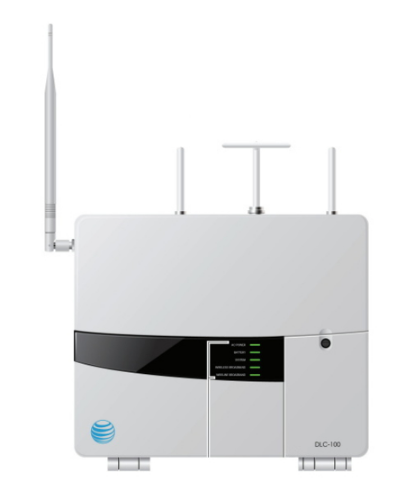
FCC Compliance Statement
FCC Regulations
The following FCC Regulations apply to most, if not all, 915MHz and 433MHz devices:
This device complies with part 15 of the FCC Rules. Operation is subject to the following two conditions: (1) This device may not cause harmful interference, and (2) this device must accept any interference received, including interference that may cause undesired operation.
This device has been tested and found to comply with the limits for a Class B digital device, pursuant to Part 15 of the FCC Rules. These limits are designed to provide reasonable protection against harmful interference in a residential installation. This equipment generates, uses, and can radiate radio frequency energy and, if not installed and used according to the instructions, may cause harmful interference to radio communications. However, there is no guarantee that interference will not occur in a particular installation. If this equipment does cause harmful interference to radio or television reception, which can be determined by turning the equipment off and on, the user is encouraged to try to correct the interference by one or more of the following measures:
- Reorient or relocate the receiving antenna.
- Increase the separation between the equipment and receiver.
- Connect the equipment to an outlet on a circuit different from that to which the receiver is connected.
- Consult the dealer or an experienced radio/TV technician for help.
Changes or modifications not expressly approved by the party responsible for compliance could void the user‘s authority to operate the equipment.
The antenna(s) used for this transmitter must not be co-located or operating in conjunction with any other antenna or transmitter.
FCC Compliance Statement for UL Certification
The following is the FCC Compliance Statement as it applies to UL Certification:
This device complies with FCC Rules and Regulations as a Part 15 device, as well as Industry Canada Rules and Regulations. Operation is subject to the following two (2) conditions:
- This device may not cause harmful interference.
- This device must accept any interference received, including interference that may cause undesired operation.
Safety Instructions
- Read these instructions.
- Keep these instructions.
- Heed all warnings.
- Follow all instructions.
- Do not use this apparatus near water.
- Clean only with a dry cloth.
- Do not block any ventilation openings. Install according to the manufacturer’s instructions.
- Do not install near any heat sources such as radiators, heat registers, stoves, or other apparatus (including amplifiers) that produce heat.
- Do not defeat the safety purpose of the polarized or grounding-type plug. A polarized plug has two blades, with one wider than the other. A grounding-type plug has two blades and a third grounding prong. The wide blade or the third prong is provided for your safety. If the provided plug does not fit into your outlet, consult an electrician for replacement of the obsolete outlet.
- Protect the power cord from being walked on or pinched, particularly at plugs, convenience receptacles, and the point where they exit from the apparatus.
- Only use attachments/accessories specified by the manufacturer.
- Use only with the cart, stand, tripod, bracket, or table specified by the manufacturer, or sold with the apparatus. When a cart is used, use caution when moving the cart/apparatus combination to avoid injury from tip-over.
- Refer all servicing to qualified service personnel. Servicing is required when the apparatus has been damaged in any way, such as a power-supply cord or plug is damaged, liquid has been spilled, objects have fallen into the apparatus, the apparatus has been exposed to rain or moisture, does not operate normally, or has been dropped.
Introduction to the Digital Life System
THANK YOU FOR CHOOSING AT&T DIGITAL LIFE for Life Safety Services. Our Life Safety Services include UL-certified fire and intrusion monitoring services. These are end-to-end AT&T services,, and the underlying AT&T Digital Life Service Architecture includes:
- AT&T Digital Life System, which is professionally installed in your home for alarm detection.
- AT&T Cellular Data Service for alarm reporting.
- AT&T Central Monitoring Centers with dedicated agents for handling alarms and contacting Emergency Services.
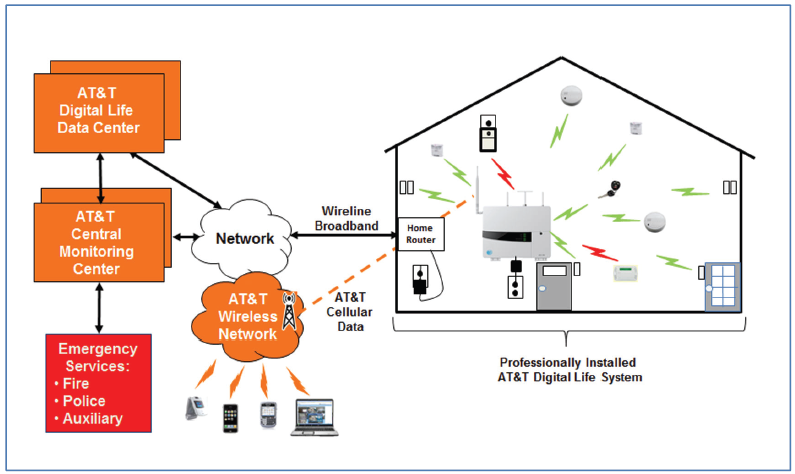
Optionally, AT&T Digital Life also offers Lifestyle Services, which include a wide range of home automation and control services. Please go to www.att.com/digitallife to learn about Digital Life – Lifestyle Services.
About Your AT&T Digital Life System
Your professionally installed AT&T Digital Life System (DLS) features a Digital Life Controller (DLC-100), which is typically installed in a closet, utility roroomor basement.
The DLC-100 is a wireless controller that monitors a wide range of devices for the detection of fire (smoke detectors and CO detectors) and intrusion (door/window sensors, motion sensors, and glass breakage sensors) alarms. Once the DLC-100 is installed and activated, it constantly monitors smoke detectors and CO detectors and automatically reports alarms to the AT&T Digital Life Central Monitoring Centers. When the system is armed, the DLC-100 automatically reports intrusion alarms to the AT&T Digital Life Central Monitoring Centers.
AT&T Digital Life Central Monitoring Centers
The AT&T Digital Life Central Monitoring Centers are state-of-the-art, 24×7, UL-certified monitoring facilities. The agents are dedicated to handling and processing alarms.
AT&T Digital Life Support
AT&T Digital Life agents are available 24/7 to provide any assistance that you require. Please call 1-855-288-2727 for immediate assistance and press the appropriate number when prompted:
- Active Alarm, press (1)
- New Service, press (2)
- Questions About Your Bill, press (3)
- Customer Care Technical Support, press (4)
In addition, you can also access www.att.com/digitallife for additional information concerning your Digital Life System.
Digital Life Controller Features and Operation
Your Digital Life System comes with a Digital Life Controller (DLC-100) that communicates with every device within your Digital Life System configuration. Your Digital Life Technician has installed your DLC-100 in a closet, utility room, or basement.
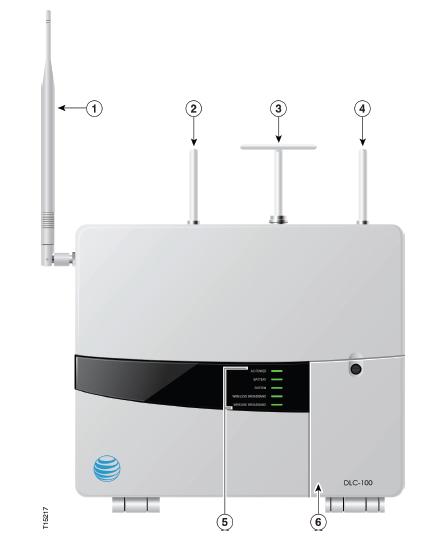
Digital Life Controller (DLC-100) Features
- AT&T Cellular Data Antenna
- Antenna for communication with smoke, carbon monoxide, and intrusion detection devices
- Antenna for communication with keypads and sirens
- Antenna for communication with smoke, carbon monoxide, and intrusion detection devices
- Five System Status LIGHTs
- Battery Compartment Door
Digital Life Controller Features and Operation
Digital Life Controller (DLC-100) Operation
The five (5) System LIGHTs on the DLC-100 door provide the following at-a-glance status:
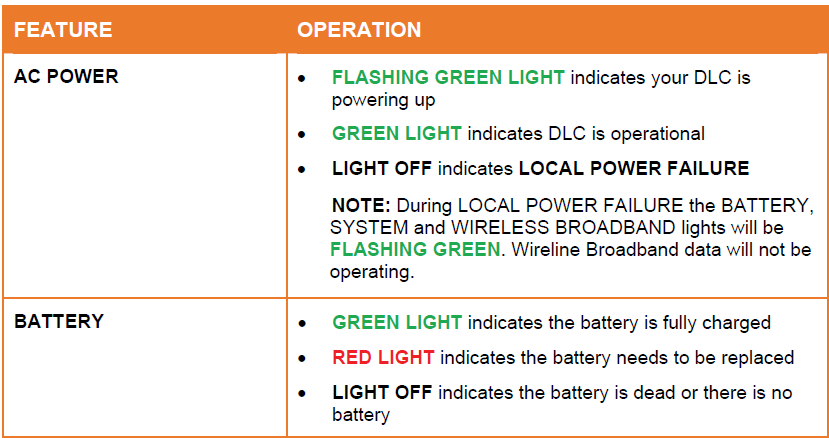
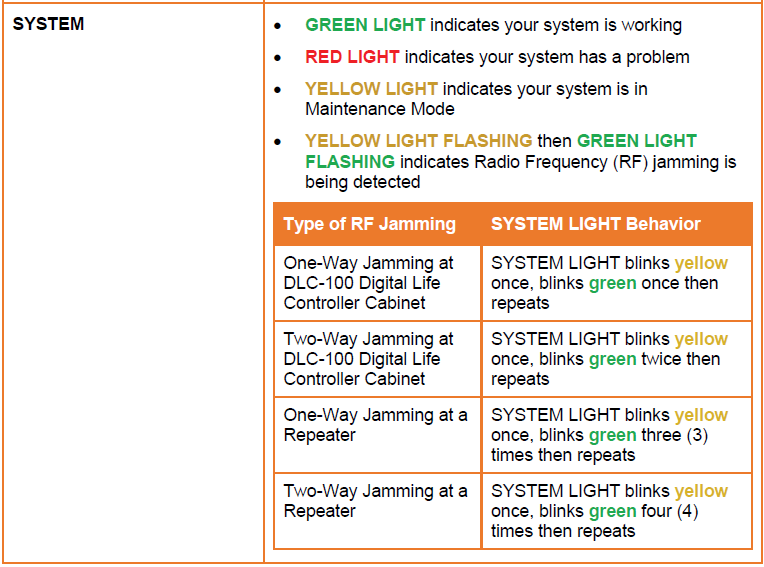

WARNING! If the SYSTEM LIGHT is flashing Yellow and then flashing Green and an auditory signal is coming from the Digital Life Controller Cabinet (DLC-100), the DLC-100 is detecting Radio Frequency (RF) Jamming. Please call 1-855-288-2727 for Customer Care Technical Support.
Replacing the Digital Life Controller (DLC-100) Battery
CAUTION: Opening the battery compartment door when the system is armed triggers the transmission of a tamper alarm to the AT&T Digital Life Central Monitoring Center. Therefore, in order to prevent a false alarm, please ensure that the system is disarmed prior to opening the battery compartment door to replace the battery.
To replace the battery:
- Make sure that the system is disarmed before opening the battery compartment door to replace the battery.
- Open the battery compartment by inserting a small coin or the blade of a small flat screwdriver into the slot on the battery compartment screw and rotating one-quarter turn to release the door.
- Connect the RED wire to the positive (+) terminal and the BLACK wire to the negative (-) terminal.

- Insert the battery into the battery compartment. Make sure to properly tuck in battery wires, so they do not get pinched between the door and frame.
Keypad Features and Operation
Your Keypad (SW-ATT-PAD2W) enables you to control basic system functions, such as arming and disarming your Digital Life System. The keypad includes an LCD, which displays system status information, and features a built-in sounder that annunciates system status information. It makes predefined “chirp” and “beep” sounds when buttons are pressed on the keypad or specific events occur. For example, the system can be configured so that the keypad chirps when an entry/exit door is opened and closed. The keypad annunciates different sounds for fire alarms and intrusion alarms. (See Appendix A for information concerning the system messages that can appear in the LCD and Appendix B for the complete list of auditory annunciations.)
The Keypad (SW-ATT-PAD2W) is powered by an AC/DC adapter that plugs into an AC power outlet. It is equipped with batteries that provide 24-hour battery backup under a local power failure condition. The batteries are customer-replaceable.
Becoming Familiar with your Keypad (SW-ATT-PAD2W) Features
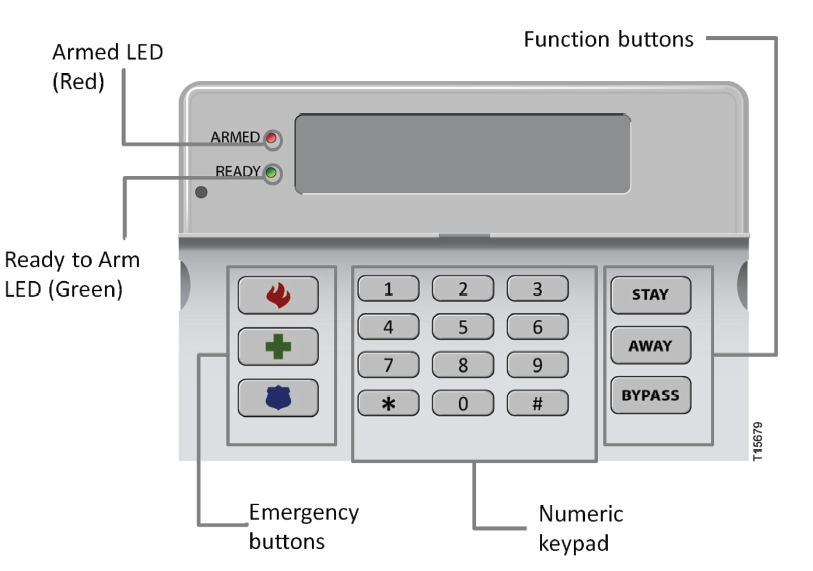
Display
The LCD the current system state and any changes in system state.
System LIGHTs
If the Armed (Red) LIGHT is ON, an LLCD display message will indicate the status of the System: Armed-STAY or Armed-AWAY.
If the Ready (Green) LIGHT is ON, the system is ready for arming.
If the Armed (Red) LIGHT is OFF and the Ready (Green) LIGHT is OFF, then the system is not ready for arming because one or more of the monitored devices, such as a door or window sensor, is not in the closed state..
Numeric Keypad
Use the Numeric keypad to enter your Alarm Panel PIN and Duress PIN, to confirm emergency button selections, and to access system functions.
Function Buttons
You can use the function buttons to select the STAY, AWA, Y, and BYPASS features.
Emergency Buttons
The Emergency Buttons are used to send an emergency alarm directly to AT&T Digital Life Central Monitoring Center immediately upon being pressed and confirmed. The Emergency Buttons are functional whether the system is armed or not.
Operating Your Keypad (SW-ATT-PAD2W)
The Keypad (SW-ATT-PAD2W) is used to arm/disarm the system and obtain information concerning the status of the system. The system has three (3) primary states:
- Ready to Arm – all of the supervised devices are in the closed state
- Not Ready to Arm – one or more of the supervised devices is not in the closed state
- Armed system is in the Armed–AWAY or Armed–STAY mode
Ready to Arm
The system is ready to be armed when the READY (Green) LIGHT is on and no message is displayed on the LCD.

Not Ready to Arm
The system is not ready to arm because one, omore, of the supervised devices is not in the closed state.
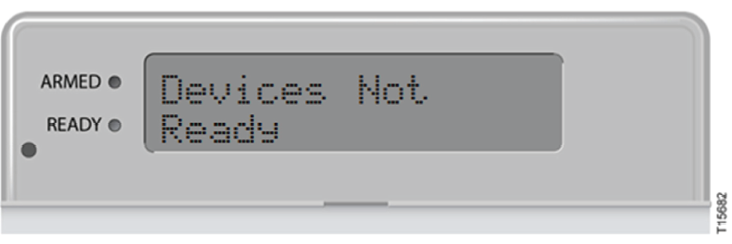
Afterwards, the keypad will display the name of the open state device(s) and cycle through the device list if there are multiple devices. Each open state device will display on a separate line.

Arming the System
Before you can arm your system, all the devices must be closed. If some devices are currently open, the Ready light will be off. Before you try to arm your system, close all doors and windows, and make sure no one is present in areas with motion sensors.
Arming the System-STAY
Press the STAY button to arm the perimeter sensors only. The system starts an exit delay timer interval. The keypad beeps, and the LCDs display “Arming – Exit Now”. Initially, the keypad beeps slowly during the exit delay timer interval and then chirps fast for the last ten (10) seconds.

If you choose to exit while Arming – STAY, you should exit through the designated entry/exit door(s) before the exit delay timer interval expires. After the exit delay timer interval expires, the system is in the Armed-STAY mode. The ARMED (Red) LIGHT is illuminated, and the LCD says “Armed – STAY”. When the system is Armed-STAY, if you open a non-designated entry/exit door or window, it will cause an alarm.

NOTE: You may disarm the system during the exit delay timer interval by entering your four (4) digit Alarm Panel PIN.
Arming the System-AWAY
Press the AWAY button to arm all of the sensors, including perimeter and interior sensors. The system generates an exit delay timer interval. The keypad beeps, and the LCDs display “Arming – Exit Now.” Initially, the keypad beeps slowly during the exit delay timer interval and then chirps fast for the last ten (10) seconds.

You should exit through the designated entry/exit door(s) before the exit delay timer interval expires. You may disarm the system during the exit delay timer interval by entering your four (4) digit Alarm Panel PIN. After the exit delay timer interval expires, the system is in the Armed—AWAY mode. The ARMED (Red) LIGHT is illuminated, and the LCDs “Armed – AWAY”.

Arming the System- BYPASS
When arming the system for STAY or AWAY, you may get a message indicating that the system cannot arm because one or more, in an open state, such as a window and/or door. You may close the open sensor(s) before arming or utilize the BYPASS feature.
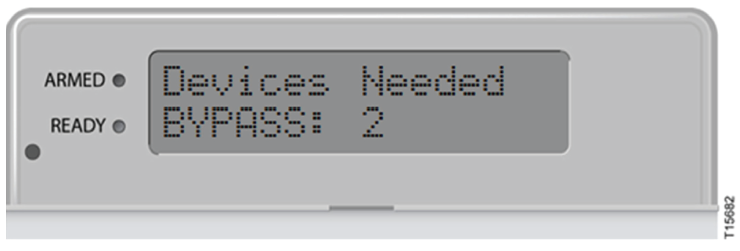
The LCD will display “Press BYPASS to Proceed.”

The identity of the open sensor(s) will appear in the LCD display.

To proceed with arming the system, either close the open sensor(s) or press the BYPASS button to bypass the sensor(s).
The system will proceed with the Arming STAY/AWAY sequence.

You should exit through the designated entry/exit door(s) before the exit delay timer interval expires. After the exit delay timer interval expires, the system is in the Armed-STAY or Armed-AWAY mode. The ARMED (Red) LIGHT is illuminated, and the LCD shows “Armed – STAY” or “Armed –AWAY”. Initially, the keypad beeps slowly during the exit delay timer interval and then chirps fast for the last ten (10) seconds.
NOTE: You may disarm the system during the exit delay timer interval by entering your four (4) digit Alarm Panel PIN.
Disarming the System – Entry Delay
When the system is in the Armed-AWAY or Armed-STAY mode and you enter the residence through a designated entry/exit door, the system generates an entry delay timer interval, and the keypad begins beeping. The entry delay timer interval allows you to get to the keypad and enter your Alarm Panel PIN before the system sounds an alarm. Initially, the keyboard beeps slowly during the entry delay timer interval and then chirps fast for the last ten (10) seconds, and the LCDs “Alarm – Enter PIN to Cancel,” as shown:

After you enter your four (4) digit Alarm Panel PIN, the READY (Green) LIGHT is illuminated and the LCD is blank.

Disarming the System
When the system is in the Armed-STAY mode or Armed-AWAY mode, you enter your four (4) digit Alarm Panel PIN to disarm the system.

After you enter your four (4) digit Alarm Panel PIN, the READY (Green) LIGHT is illuminated and the LCD is blank.

Alarm Sounding-Cancel Alarm
If an alarm is triggered by opening a protected window or door while the system is armed, the siren will start sounding, the keypad will start beeping, and the LCD will show” Alarm – Enter PIN to Cancel.”

The keypad also displays the name of the device(s) that is/are triggered.

You can cancel the alarm by entering your four (4) digit Alarm Panel PIN. The LCD will display “Alarm Canceled” and then will be blank.

Sending a Fire Emergency Alarm
In the case of a fire, press the FIRE button. You will be prompted to press the asterisk (*) key to confirm the Fire Emergency, as shown.

After you press the asterisk (*) key, a fire alarm will be sent to the AT&T Digital Life Central Monitoring Center, and the keypad will display “FIRE Emergency Sent,” as shown:

The alarm has been sent to the AT&T Digital Life Central Monitoring Center, and after a few seconds, the “Alarm – Enter PIN to Cancel” message displays:

You may cancel the alarm by entering your four (4) digit Alarm Panel PIN on the keypad.
Sending an Auxiliary Emergency Alarm
An AUX Emergency is any emergency other than Police, Fire, or Medical, such as a flooded basement or a downed power line. In case of an Auxiliary Emergency, press the AUX button. You will be prompted to press the asterisk (*) key to confirm the AUX Emergency, as shown.

After you press the asterisk (*) key, an AUX Emergency alarm will automatically be sent to the AT&T Digital Life Central Monitoring Center, and the keypad will display “AUX Emergency Sent” as shown:

The alarm has been sent to the AT&T Digital Life Central Monitoring Center, and after a few seconds, the “Alarm – Enter PIN to Cancel” message displays:

You may cancel the alarm by entering your four (4) digit Alarm Panel PIN on the keypad.
When the Auxiliary Emergency alarm is received by the AT&T Digital Life Central Monitoring Center, an agent will begin calling the numbers in your call list, starting with the first contact number in your call list.
Sending a Police Emergency Alarm
In case of a police emergency, press the POLICE button. You will be prompted to press the asterisk (*) key to confirm the Police Emergency, as shown.

After you press the asterisk (*) key, a Police Emergency alarm will automatically be sent to the AT&T Digital Life Central Monitoring Center.The key pad will display “POLICE Emergency Sent” as shown:

The alarm has been sent to the AT&T Digital Life Central Monitoring Center, and after a few seconds, the “Alarm – Enter PIN to Cancel” message displays:

You may cancel the alarm by entering your four (4) digit Alarm Panel PIN on the keypad.
Entering Your Duress PIN
You can call a Digital Life Customer Care Technical Support agent to assist you in creating or changing your optional four (4) digit Duress PIN, or you can access www.att.com/dlpin (See Digital Life Customer Care Technical Support).
A duress signal is sent to the AT&T Digital Life Central Monitoring Center by you entering your Duress PIN on the keypad when you feel threatened due to one or more person(s) trying to force you to enter or re-enter your home. After receiving the Duress Alarm, an agent will place a call to the police and report the Duress Alarm. The Duress PIN can be entered at any time. Entering the Duress PIN generates a silent alarm. The siren will not sound, and there will be no indication on the display that the Duress PIN has been entered.
Keypad Operation Quick Reference
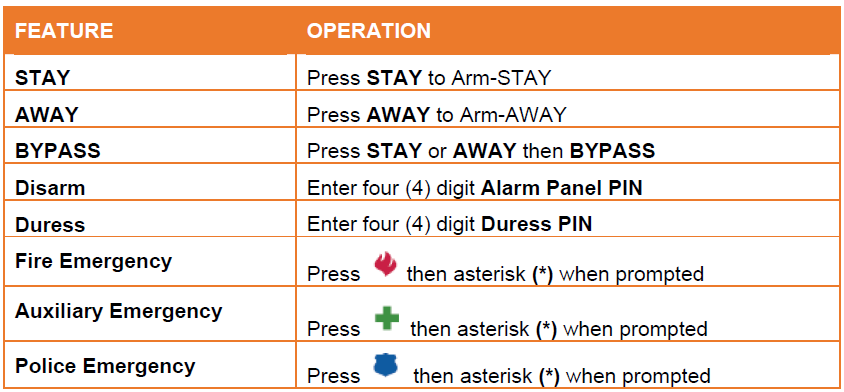
Replacing the Keypad (SW-ATT-PAD2W) Batteries
Your Keypad (SW-ATT-PAD2W) requires four (4) AA alkaline batteries (Duracell® MN1500, Energizer® EN91, or Panasonic® LR6XWA) for 24-hour battery backup and will indicate when it is time to replace the batteries by producing a chirping sound and displaying the following message on the LCD, “Keypad – Low Battery.”
CAUTION: Opening the battery compartment door when the system is armed triggers the transmission of a tamper alarm to the AT&T Digital Life Central Monitoring Center. Therefore, in order to prevent a false alarm, please ensure that the system is disarmed prior to opening the battery compartment door to replace the batteries.
To replace the batteries:
- Make sure that the system is disarmed before replacing the batteries.
- Slide the keypad upward to remove the keypad from the base.
- Turn the keypad to the backside.
- Remove all existing batteries and dispose of them properly.
- Insert four (4) AA alkaline batteries (Duracell® MN1500, Energizer® EN91, or Panasonic® LR6XWA).
 NOTE: Observe the polarity of the batteries for correct battery installation.
NOTE: Observe the polarity of the batteries for correct battery installation. - Restore the keypad to its base.
For more manuals by AT&T, visit ManualsLibraryy
AT&T DLC-100 Digital Life Controller Home Alarm-FAQs
How do I turn off my DLC-100 alarm?
If the system is beeping due to low battery or power loss:
Locate the control panel.
Disconnect the backup battery.
Restore power & replace the battery if needed.
Can I use the DLC-100 without AT&T monitoring?
Yes, but only as a local alarm (no emergency alerts). You’ll need to self-monitor via the app (if still functional).
How do I stop false alarms?
Check sensor alignment (doors/windows).
Replace low batteries in sensors.
Avoid placing motion detectors near heat sources.
What’s the lifespan of a home alarm battery?
Backup battery: 3–5 years (typically 12V 7Ah).
Sensor batteries: 1–2 years (check for low-battery alerts).
Can I remove the DLC-100 system myself?
Wireless sensors: Easy to uninstall.
Wired systems: Hire an electrician to avoid damage.
Are there security systems with no monthly fees?
Yes! Top no-fee options:
Ring Alarm (Self-monitoring, optional $10/month for professional alerts).
SimpliSafe (No contract, optional monitoring).
Abode (Free basic plan + smart home features).
Why does my alarm beep during a power outage?
The backup battery is low or failing. Replace it to restore full functionality.
How do I check if my DLC-100 is still working?
Test sensors by triggering them (open a door/window).
Listen for the local alarm siren.
Check the app (if still connected).
Can I reuse AT&T Digital Life sensors?
Most won’t work with other systems. Consider upgrading to a new platform like Ring or SimpliSafe.
How do I dispose of my old DLC-100 system?
Recycle batteries at a designated facility.
E-waste drop-off for the control panel.

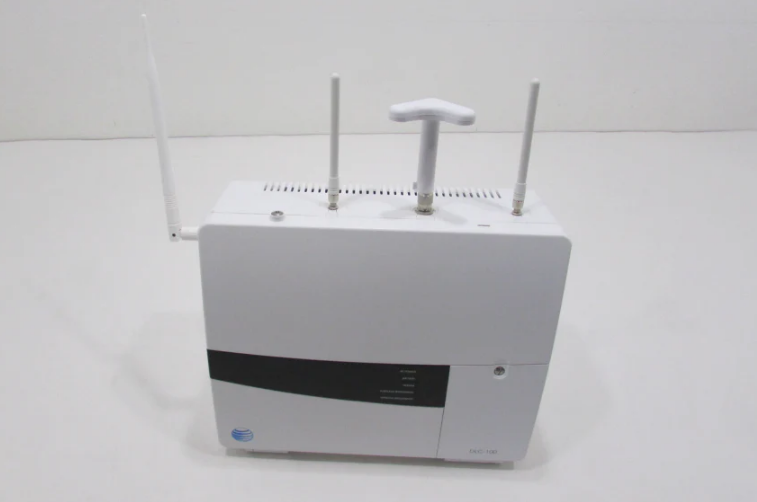
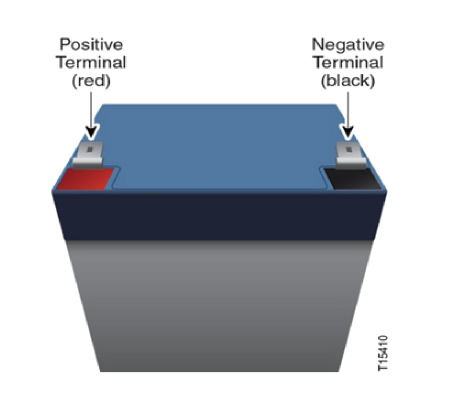
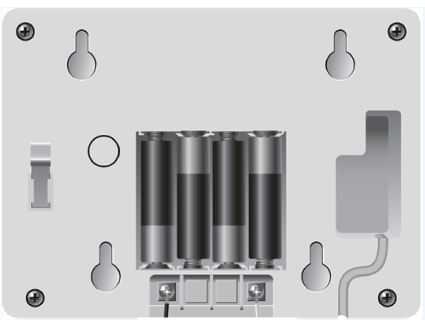 NOTE: Observe the polarity of the batteries for correct battery installation.
NOTE: Observe the polarity of the batteries for correct battery installation.